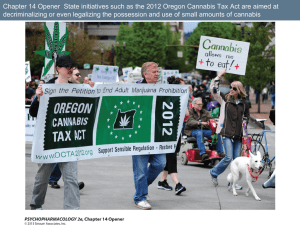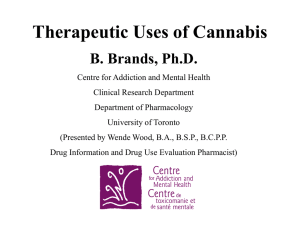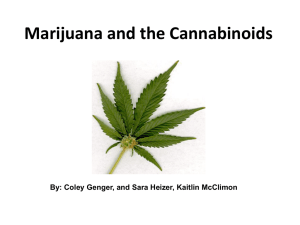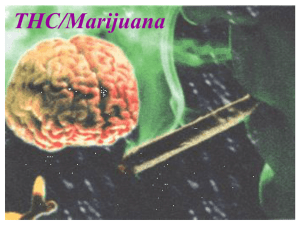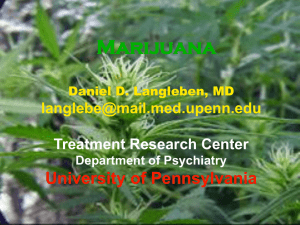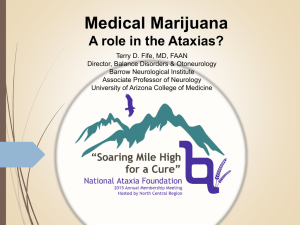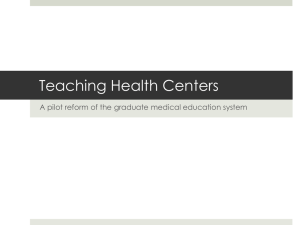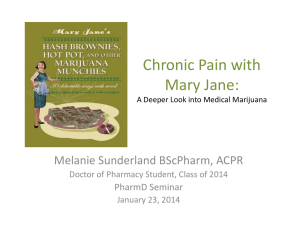The Clinical Pharmacology of Medical Cannabis
advertisement
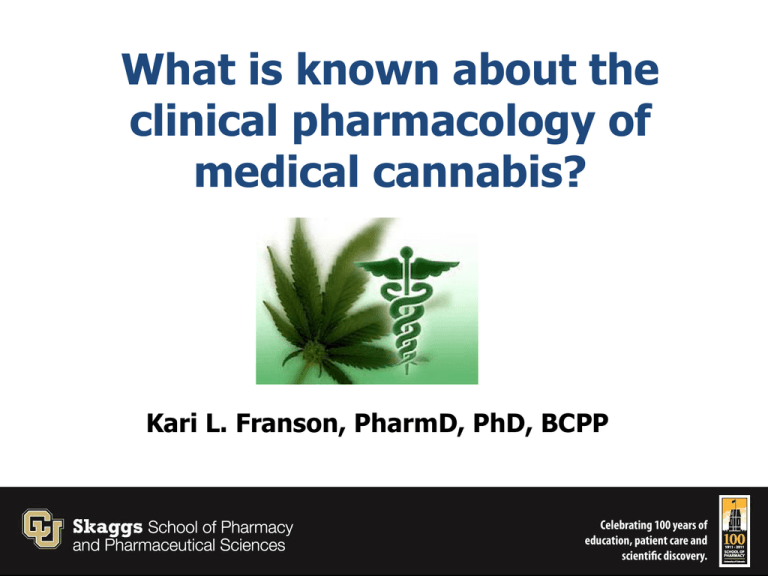
What is known about the clinical pharmacology of medical cannabis? Kari L. Franson, PharmD, PhD, BCPP Disclosure Statement • Dr. Franson has no financial investments and receives no funding from any of the private companies talked about in this presentation • Dr. Franson will be discussing unapproved drugs and unapproved uses for drugs. • This presentation is based on Borgelt LM, Franson KL, Nussbaum Am, Wang GS. “The Pharmacologic and Clinical Effects of Medical Cannabis” Pharmacotherapy 2013;33(2):195–209 At the end of the session, participants will be able to: 1) explain what cannabis does to the human body with a focus on THC & CBD (pharmacology) 2) compare the various routes of cannabis administration and how the human body manages the drug (pharmacokinetics) 3) evaluate new Colorado Amendment 64 legislation considering what is known about clinical pharmacology Pharmacology Cannabis (sativa, indica, ruderalis) Plant-derived cannabinoids – – – – – – – – – – ∆9 -tetrahydrocannabinol (9) - THC ∆9 -tetrahydrocannabivarin - THCV Cannabidiol (7) - CBD Cannabigerol (6) Cannabichromene (5) Cannabicyclol (3) Cannabielsoin (5) Cannbitriol (9) Cannabinol Miscellaneous (11) Br J Pharmacology 2006;147:S163-171 Cannabinoid/CB receptor interactions Cannabinoid receptor active ligands Normal neurotransmission Regulatory effects of cannabinoids Pertwee RG, Br J Pharm, 2008 Normal neurotransmission in a network Regulatory effects of cannabinoids Pertwee RG, Br J Pharm, 2008 Distribution of CB1 & CB2 receptors CB1 CB2 – – immunologic cells (modulation cell migration) microglia (possible role in Alzheimer’s?) Cannabis effect on reward pathway DA: reward and motivation Glu: learning and memory GABA: inhibition of neuronal activity Brain development in adolescence Accumbens – Immediate rewards – Impulsive behavior Cortex – Long term gain – Thoughtful behavior http://erichengelhardt.net/neuro-facts.html accessed 5/28/2013 Amendment 64 prohibits the sale and use of cannabis products by those younger than 21 years. Why? The adolescent brain is still developing. There is concern that the reward pathways and feedback loops may be altered if cannabis is used by those with still developing brains. Non-cannabinoid targets linked to cannabis • • • • • • Other G-protein receptors: GPR55, GPR55940, etc G-protein-coupled receptors: noncompetitive inhibitor at μ- and -opioid receptors, NE, DA, 5-HT Ligand-gated ion channels: antagonism at 5-HT3, nicotinic, and enhance activation of glycine receptors Transient receptor potential channels (TRPVs): bind and activate TRPV1 similar to capsaicin, also CB1 receptors are located near TRPV1 Ion channels: inhibition of Ca, K, Na channels by noncompetitive antagonism Peroxisome Proliferator-Activated Receptors: PPAR and PPAR are activated Pertwee RG, Pharma Rev 2010 What is in medical cannabis? www.fullspectrumlabs.com Accessed 07/18/2011 To review: What does THC do to the human body? – it is a partial agonist for the CB1 receptor – CB1 receptors regulate the release of other neurotransmitters – CB1 receptors are primarily located in the brain; effecting thinking, memory, appetite, reward and movements – It is the most psychoactive substance in cannabis What does CBD do to the human body? Pharmacokinetics Pharmacokinetic profile of THC Smoking: • Bioavailability: 10-25% 50% of the THC content is delivered into smoke 50% of smoke is exhaled again 60% of inhaled smoke may be metabolized in the lung • Peak concentrations are high and reached within minutes • t½ distribution 0.5 hr, t½ for elimination 30 hr Agurell S, 1986; Strougo A, 2005 Vaporization of medical cannabis • Cannabinoids vaporize at a temp lower than combustion • Increasingly popular • Lower % of noxious chemicals http://www.volcanovaporizer.com/products-page/complete-sets/ Accessed 08/31/2012 Pharmacokinetic profile of THC Oral: •Bioavailability: 5-20% Often considered 1/3 that of smoked due to gastric degradation and extensive first-pass effects High intra-patient variability! •Multiple peak concentrations are low and reached in 1-3 hr •t½ absorption 0.8 hr, t½ distribution 3.8 hr t½ for elimination 25 hr Agurell S, 1984; Ohlsson A, 1980 THC is the most psychoactive component of cannabis Typical “effective” dosing of THC • Low dose < 7 mg • Medium dose = 7 – 18 mg • High dose > 18 mg There is a known tolerance to THC via down regulation of CB1 receptors High probability of tolerance with chronic use, and low with intermittent Zuurman L, Brit J Clin Pharm 2009 CO HB 13-1317 labeling of product • A net weight statement; • THC potency and the potency of such other cannabinoids or other chemicals, including but not limited to CBD, • A serving size for edible retail marijuana products that does not contain more than ten milligrams of active THC, …, and limitations on the total amount of active THC in a package that is no more than one hundred milligrams of active THC; How much should a person use to get 25 mg of THC? • 20% THC • Net weight 1/8 oz or 3.5 gm • Single serving 50 mg http://bothcollective.com/page/6/?app-download=windowsphone http://onehumanbeing.com/the_mmj_project/2009/03/granddaddy-purple-at-cclb/ The pharmacodynamics of THC • Evaluated 165 studies to determine consistently found PD effects – Elevation in heart rate (average >19 bpm) – Increase in subjective feeling high – Decrease in subjective alertness – Increase in motor instability (body sway) Zuurman L, Brit J Clin Pharm 2009 • Subjects given increasing doses (2, 4, 6, 8 mg) of THC via Volcano vaporizer at 1.5 hr intervals Adapted from Zuurman L, Brit J Clin Pharm 2009 THC (ng/ml) PK/PD modeling of THC Time (hr) PK/PD modeling of THC Heart rate (bpm) Time (hrs) heart rate VAS feeling high (U) Time (hrs) feeling high VAS alertness (mm) Time (hrs) alertness Adapted from Zuurman L, Brit J Clin Pharm 2009 A man in a MVA is found to have a blood THC level of 10 ng/ml. House Bill 1325 set THC limit at 5 ng/ml 1. The man did not reach the level of impairment 2. The man was above the known level of impairment 3. The level of presumptive impairment is not known 4. It is not known if the man was impaired with this concentration Population response to medical cannabis • Hormones: – Males: decreased LH, FSH, prolactin, and GH levels – Females: more sensitive to THC effects (pain, behavior, reward) with higher estrogen levels • Tobacco: greater increases in HR and carbon monoxide, despite lower THC concentrations • MDMA: synergistic impairment in working memory • CV patients: ↑HR and ↓HRV with cannabis use Acute toxicities • • • • Hallucinations Tachycardia Labored breathing Obtundation Wang GS JAMA Pediatrics, 2013 http://opiophilia.blogspot.com/2013_04_01_archive.html Gable (2006) Amer Scientist 94:206. To review: What does the human body do to THC? – Smoking THC mimics IV, but with 10-25% bioavailability, quick effect easy to titrate – Ingesting THC, 1/3 bioavailability, high variability and delayed effect increased toxicities – Medium dose 10mg, giving rise to ↑HR, ↑high, ↓alertness, ↓stability, but tolerance quickly develops – Acute THC ingestions are relatively safe Wrap-up from today’s session 1) Explained the pharmacology of THC & CBD 2) Compare the pharmacokinetics with various forms of cannabis 3) Examined new Colorado legislation considering what is known about clinical pharmacology 4) Questions?
